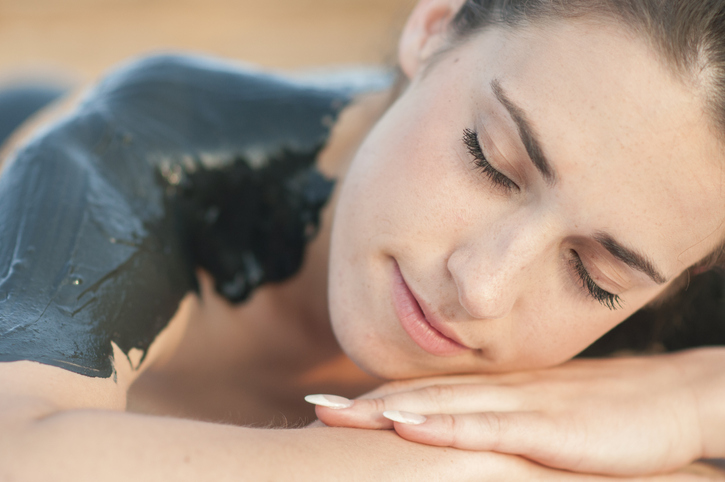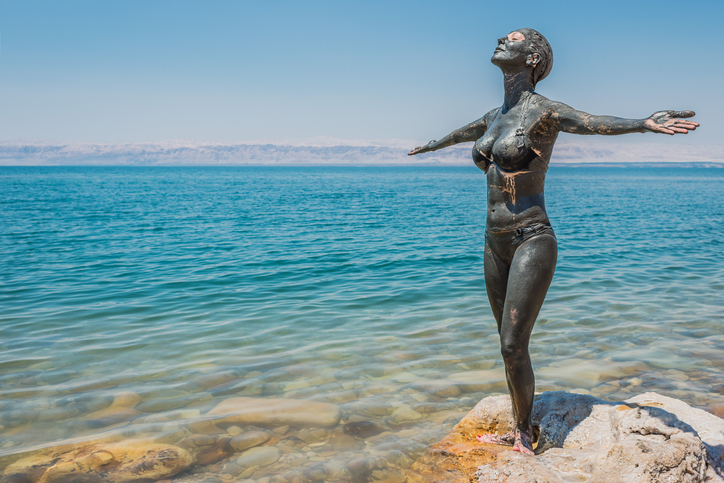A well-known therapeutic treatment, a mud bath or a bath with mud, is the practice of soaking in a pool of peat, water, and volcanic ash that tends to be an incredibly relaxing and oftentimes joy-inducing, experience. This detox therapy is said to have been around since ancient times. One of the hottest natural treatments, mud bath therapy was used by ancient Greeks and the Wappo tribe of present-day California due to its healing properties. Even greats such as Napoleon and Cleopatra’s beauty regimens involved getting a little soak inside mud baths. If this is the first time you’re about to hop inside a mud bath, don’t worry—we have some basic tips and advice for you to check first.
Different Kinds Of Muds Used For Mud Baths

Sadly, you can’t just roll in the nearest puddle when it rains and call it a mud bath. Only certain regions are blessed with the right geological conditions to create mud that is rich in the required kind of minerals such as magnesium, sodium, and sulfur. There are different types of mud baths as well. While the ‘mud’ contains common minerals such as sulfur, zinc, bromide, and magnesium, it may also include peat, volcanic ash, or specific salts depending on the region. There are different sources of mud baths:
- Lakes such as Lake Techirghiol in Romania are also known as ‘moor mud’, and come from ancient lakes in peaty areas of Europe. This mud contains sodium, chlorine, potassium, calcium, and sulphur. It hence replenishes nutrients in the body and improves skin conditions such as arthrosis, psoriasis, dermatitis, eczema, respiratory diseases, and intestinal disorders.
- Saltwater seas like the Dead Sea in Jordan and Israel are salt-heavy mud that is rich in magnesium, calcium, potassium, and iron and has also been known to help skin disorders.
- Hot springs such as Calistoga in Napa Valley, California, have mud that contains volcanic ash, and when mixed with mineral water from the surrounding hot springs, become an especially nutritional treat for skin cells.
- Mud volcanoes like El Totumo, Colombia, consisting of a mixture of volcanic mud and thermal water occurring due to geological processes over many years. Volcanic mud contains mainly these mineral salts such as sulfur, magnesium, and zinc. It is known for its exfoliating and anti-inflammatory properties.
It’s best to pick the therapy according to the qualities of the mud you want.
Mud Baths And Benefits:
1. A mud bath, due to its high temperature, draws out impurities or toxins from the skin, thereby nourishing your skin. This detoxification leaves you with softer, fresher skin.
2. One of the benefits of mud baths is their soothing effect. Since the mud is cooling in nature, this therapy is often prescribed by naturopaths and alternative healers to deal with stress, sleep disorders, and even anxiety.
3. Mud baths have highly active physical and chemical properties and soaking in them can help relieve the symptoms of many dermatological diseases such as psoriasis, eczema, and rosacea. The regenerative and antiseptic properties of mineral-rich mud help to adjust endocrine disorders which can prevent and cure acne from the inside out, helping skin heal.
4. Soaking in mud and its minerals can help alleviate aches and muscle pains, as it relaxes sore muscles and joints. Studies have even shown that mud baths can improve the balance of the nervous system, helping patients with spondylitis, rheumatoid arthritis, chronic rheumatoid arthritis, spinal pain, chronic diseases of the musculoskeletal system, and peripheral neuropathies.

5. The sulfur in the mud is said to slow down a person’s aging process because of its ability to protect against the toxic effects of pollution and radiation.
6. The mud has anti-inflammatory properties. Zinc prevents inflammation while magnesium salts alleviate inflammatory disorders of skin and joints.
Things To Remember During Mud Baths:
- Temperature: Keep in mind that the mud will likely be kept between 100 to 104 degrees F, which is about the temperature of a hot tub. This helps to invigorate circulation in the body.
- Clothes: Depending on the location, you may be asked to remove your clothing. The mud is supposed to stick to the body to help remove the toxins by drawing them out through your lymph nodes and the pores on your skin. The more exposed you are, the better. However, if you don’t wish to go in naked, it’s completely acceptable to wear a bathing suit or a pair of T-shirts and shorts, underwear that you can discard afterward.
- Going In: You have to gently immerse yourself in the mud because it may take a while to adjust to the temperature. If you are at a mud bath spa, you can take the help of the spa attendant to make sure you’re comfortable. And if you are out in nature, don’t worry, you will not sink. Your body will be completely suspended in the mixture and you’ll feel as though you’re floating. This is one of the reasons why mud therapy helps to soothe or relax the body. Wherever you are, remember you have to submerge yourself, the mud should cover your entire body, and come up to your chin.

- Avoid Eyes And Mouth: If you are at a mud bath spa, you can ask the attendants about the kind of mud used and the number of times it has been changed for hygiene reasons. And if you are by a sea or lake and the mud is not deep enough to immerse yourself in, pick up generous handfuls of mud and smear it across your exposed skin but avoid your eyes and mouth. Observe how others around you are rubbing mud on themselves, and follow suit. Lay out in the sun after applying the mud, allowing it to dry on your skin and allow easier removal.
- Time Honoured Treatment: If you are not immersed, but have chosen to coat your body with mud instead, you should still limit your time to about 15-30 minutes. If you’re by a lake or in a remote location, you’ll still need to keep track of the time yourself.
- Rinsing: Don’t stress if you don’t have access to soap; a thorough rinse will remove all the mud from your body. However, do resume a normal shower schedule following the mud bath. And if you are having multiple treatments at the spa, take the mud bath before the massage.
- Smell: Keep in mind that mud’s essential minerals often have a high sulfur content which is why the mud might be a little smelly.
- Limitations On People With Medical Conditions: Pregnant women or anyone with high or low blood pressure, a heart condition, skin infection or broken skin (including rashes such as eczema or psoriasis), or heat sensitivity will need to consult a doctor before undertaking any mud treatment.
Dunk In These Best Natural Mud Baths Around The World (will contain pictures)
1. Boryeong, South Korea
2. Calistoga Hot Springs, California
3. Hell’s Gate, New Zealand
4. Volcán El Totumo, Colombia
5. Dead Sea, Israel

6. Milky Way Lagoon, Palau

7. Lake Techirghiol, Romania
How About A Soothing Sesh In Natural Therapeutic Mud Bath
The unique composition of natural mineral-rich mud offers various health benefits and thus mud baths have their own fan following across the globe. Whether you’re travelling or just planning to enjoy the weekend, what can be more relaxing or more soothing than a good soak? This time instead of your usual spa session book a mud bath to relax, recharge, and even improve your skin. If you’ve already tried mud bath therapy, tell us all about your experiences in the comments below.
Also Read: Visit 8 Of The Best Onsen In Japan For Wellness Tourism


